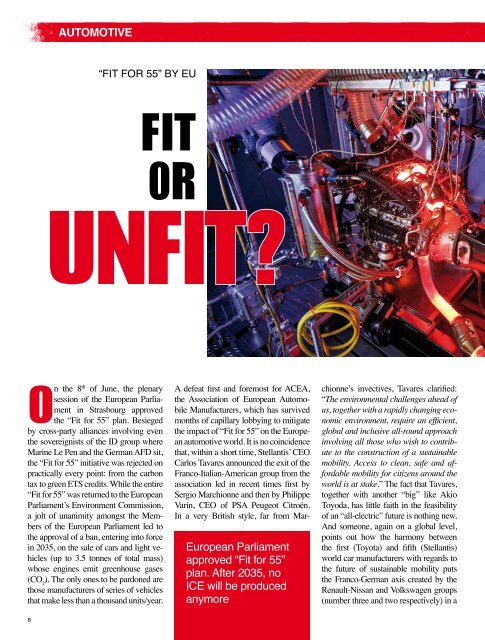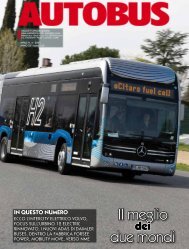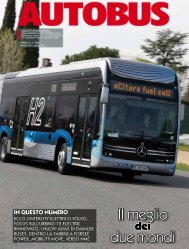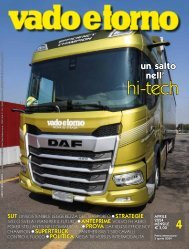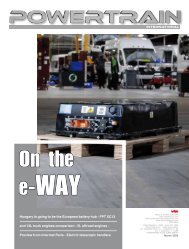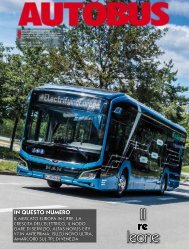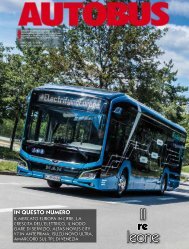Powertrain | Diesel International 2022-09
EMISSIONS CUMMINS: How to reduce consumption POWER GENERATION ROLLS-ROYCE POWER SYSTEMS: Symposium, where to experience the future EXHIBITIONS VENICE BOAT SHOW: Electric, hydrogen, diesel, LPG INTERVIEWS FPT INDUSTRIAL: Growing fast in the US and China ENGINES MAN ENGINES: Dual fuel hydrogen-engines (and V12X 2200hp) OFF-SHORE: OXE and Cox “run” diesel SCANIA: An orange mermaid at the Genoa Boat Show WÄRTSILÄ: Sustainable Technology Hub VOLVO PENTA: IMO Tier III D13 for work boats BOATS FISH-EYE: Yanmar to power Lyman-Morse Hood 35LM GERRISBOATS: A disruptive hull for electric tenders ALTERNATIVE FUELS CHEVRON: Global Centre for Maritime Decarbonisation THINK PINK UNIVERSITY OF COVENTRY: Lorena Moreira is a brilliant young engineer COLUMNS Editorial; Newsroom; Automotive; Techno
EMISSIONS
CUMMINS: How to reduce consumption
POWER GENERATION
ROLLS-ROYCE POWER SYSTEMS: Symposium, where to experience the future
EXHIBITIONS
VENICE BOAT SHOW: Electric, hydrogen, diesel, LPG
INTERVIEWS
FPT INDUSTRIAL: Growing fast in the US and China
ENGINES
MAN ENGINES: Dual fuel hydrogen-engines (and V12X 2200hp)
OFF-SHORE: OXE and Cox “run” diesel
SCANIA: An orange mermaid at the Genoa Boat Show
WÄRTSILÄ: Sustainable Technology Hub
VOLVO PENTA: IMO Tier III D13 for work boats
BOATS
FISH-EYE: Yanmar to power Lyman-Morse Hood 35LM
GERRISBOATS: A disruptive hull for electric tenders
ALTERNATIVE FUELS
CHEVRON: Global Centre for Maritime Decarbonisation
THINK PINK
UNIVERSITY OF COVENTRY: Lorena Moreira is a brilliant young engineer
COLUMNS
Editorial; Newsroom; Automotive; Techno
Create successful ePaper yourself
Turn your PDF publications into a flip-book with our unique Google optimized e-Paper software.
AUTOMOTIVE<br />
#INTERNALCOMBUSTIONENGINES #DECARBONIZATION #EUROPEANUNION<br />
“FIT FOR 55” BY EU<br />
FIT<br />
0R<br />
UNFIT?<br />
“Fit for 55” refers to the EU’s target of reducing net<br />
greenhouse gas emissions by at least 55% by 2030 .<br />
On the 8 th of June, the plenary<br />
session of the European Parliament<br />
in Strasbourg approved<br />
the “Fit for 55” plan. Besieged<br />
by cross-party alliances involving even<br />
the sovereignists of the ID group where<br />
Marine Le Pen and the German AFD sit,<br />
the “Fit for 55” initiative was rejected on<br />
practically every point: from the carbon<br />
tax to green ETS credits. While the entire<br />
“Fit for 55” was returned to the European<br />
Parliament’s Environment Commission,<br />
a jolt of unanimity amongst the Members<br />
of the European Parliament led to<br />
the approval of a ban, entering into force<br />
in 2035, on the sale of cars and light vehicles<br />
(up to 3.5 tonnes of total mass)<br />
whose engines emit greenhouse gases<br />
(CO 2<br />
). The only ones to be pardoned are<br />
those manufacturers of series of vehicles<br />
that make less than a thousand units/year.<br />
A defeat first and foremost for ACEA,<br />
the Association of European Automobile<br />
Manufacturers, which has survived<br />
months of capillary lobbying to mitigate<br />
the impact of “Fit for 55” on the European<br />
automotive world. It is no coincidence<br />
that, within a short time, Stellantis’ CEO<br />
Carlos Tavares announced the exit of the<br />
Franco-Italian-American group from the<br />
association led in recent times first by<br />
Sergio Marchionne and then by Philippe<br />
Varin, CEO of PSA Peugeot Citroën.<br />
In a very British style, far from Mar-<br />
European Parliament<br />
approved “Fit for 55”<br />
plan. After 2035, no<br />
ICE will be produced<br />
anymore<br />
chionne’s invectives, Tavares clarified:<br />
“The environmental challenges ahead of<br />
us, together with a rapidly changing economic<br />
environment, require an efficient,<br />
global and inclusive all-round approach<br />
involving all those who wish to contribute<br />
to the construction of a sustainable<br />
mobility. Access to clean, safe and affordable<br />
mobility for citizens around the<br />
world is at stake.” The fact that Tavares,<br />
together with another “big” like Akio<br />
Toyoda, has little faith in the feasibility<br />
of an “all-electric” future is nothing new.<br />
And someone, again on a global level,<br />
points out how the harmony between<br />
the first (Toyota) and fifth (Stellantis)<br />
world car manufacturers with regards to<br />
the future of sustainable mobility puts<br />
the Franco-German axis created by the<br />
Renault-Nissan and Volkswagen groups<br />
(number three and two respectively) in a<br />
difficult position, since they count on the<br />
economic incentives promised by the<br />
governments of Paris and Berlin; neutral<br />
on this issue is Hyundai-Kia (number<br />
four), drawing its strength from the experience<br />
accumulated in China. Tavares’<br />
“free hands” choice has a motivation<br />
that highlights his skills as a pragmatic<br />
manager. If the Greens are celebrating<br />
the “Stop in 2035”, the chaos staged<br />
in Strasbourg on the 8 th of June and –<br />
above all – the implosion on “Fit for 55”<br />
of the majority, that has so far supported<br />
the Commission in the European Parliament,<br />
represents a golden opportunity<br />
for Stellantis’ CEO in view of the second<br />
half of the game, the opening of which<br />
is scheduled for the 28th of June, with<br />
the EU Council of Environment (we<br />
are writing a few days before this date,<br />
editor’s note). The hypothesis is that the<br />
meshes of the EU project will widen,<br />
lowering the expected reduction in CO 2<br />
emissions from 100 to 90 percent, an objective<br />
that is not impossible for internal<br />
combustion engines already in the Euro7<br />
version. However, in the EU buildings,<br />
many politicians and officials seem to<br />
ignore two key facts. The first one is that<br />
only 12 percent of CO 2<br />
emissions in the<br />
whole EU comes from cars. No one, in<br />
fact, has contradicted the well-known<br />
study according to which, on an annual<br />
basis, the cruise ships anchored with<br />
their generators running at the harbour<br />
of Barcelona pollute as much as the entire<br />
European car fleet. In terms of global<br />
impact on the planet, then, the 2021<br />
registration figures show that the 16.8<br />
million new vehicles in the European<br />
area represent only 20 percent of the<br />
world figure, which sees Asia in the lead<br />
with 42.6 million vehicles, where China<br />
stands out with its 26.2 million cars.<br />
Eliminating EU emissions, therefore,<br />
risks to be more of an exercise in style<br />
rather than an advantage for the environment.<br />
Without forgetting the problem of<br />
raw materials, as Andrea Boitani, Professor<br />
in Transport Economics at the Catholic<br />
University of Milan, pointed out:<br />
“The Chinese have been quicker, and as<br />
for rare earth elements, especially lithium<br />
(essential for batteries), they have<br />
already signed exclusive and advantageous<br />
agreements with the governments<br />
of their producer countries, mostly in Africa.”<br />
If it is true that “failure is simply<br />
the opportunity to begin again, but this<br />
time more intelligently”, as Henry Ford<br />
loved repeating, perhaps the Strasbourg<br />
disaster could be a new beginning for the<br />
European automotive industry.<br />
8<br />
9


